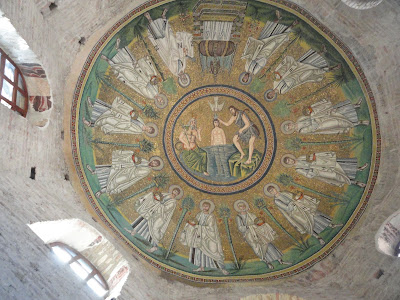So.
A fairly early start (for us); we got down to the hotel breakfast before 9am. That was good and a very pleasant change from a cafe on the Roman piazza.
I ran back to the car for what I hope to be the last time to get a few things we'd forgotten and then we launched into a day of looking at mosaics.
The story of Galla Placidia (c.AD390-450) certainly starts with a bang: a young princess - granddaughter and daughter of Roman emperors, sister of the Western emperor then ruling at Ravenna, and aunt of the reigning emperor at Constantinople - is living in Rome at the time of its siege and sack by the Goths in 410. Galla is taken hostage, wanders with the Goths for three years, marries the Gothic king Athaulf in Narbonne and moves with the barbarians to Barcelona. When Athaulf is murdered, the next elected king trades her back to the Romans in exchange for grain; she marries (perhaps unwillingly) Constantius, the Roman general who had been clamouring for her release. And she isn't yet 25 years old.A remarkable small building filled with marvelous mosaics of which these pictures are a small sample; we have dozens more. The final picture is a detail of exactly how a particular mosaic effect was achieved. I took quite a few of these for Nancy's future reference.
Across a small lawn is the Basilica di San Vitalle, again with remarkable mosaics. Nancy liked the way the gold was set in at slight angles making the effect sparkle as we walked by. She was absorbing technique as much as beauty. The church itself was the model by which Hagia Sophia in Constantinople/Byzantium/Istanbul was built.
We then headed back to the hotel for a bit of a lie down then moved on.
Just around the corner and in the angle of a crooked alley is the Arian Baptistry. I won't get into a long boring disquisition about who the Arians were other than to say that they were what is not considered Christian heretics, sometimes they were considered orthodox, and all this killed quite a few people.
The Baptistry itself is quite small and I gather that it's original frescoes are gone. All this is left of the artwork is this great mosaic on the dome showing, appropriately, Jesus getting baptized flanked by a personification of the River Jordan and John the Baptist. I loved the effect used to show the water.
And then a pleasant short walk back to the hotel.
We returned to the same restaurant as last night and had another great meal. On the way out we bumped into the lady with whom we had been so effusive last night about our meal. It turns out that she and her two daughters (at least) work there. One daughter was working so this woman, her other daughter, and her mother were sitting dining outside. They greeted Nancy like a long lost relative and for half an hour or so we chatted back and forth. Nancy gave the mother one of her bags. Nancy; the woman has a gift.


























How lovely. You can see the warm exchange between Nancy and the women. She never meets a stranger!
ReplyDeleteThank you for the thoughts although I'm not entirely sure who "E" is.
Delete